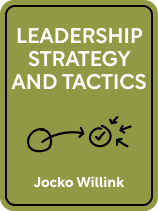

This article is an excerpt from the Shortform book guide to "Leadership Strategy and Tactics" by Jocko Willink. Shortform has the world's best summaries and analyses of books you should be reading.
Like this article? Sign up for a free trial here.
Want to know how to improve team communication? How do the greatest leaders communicate with their teams?
According to leadership expert and author Jocko Willink, the key to being a good leader is putting others before yourself. In Leadership Strategies and Tactics, he explains how to improve team communication by building quality relationships, trust, and taking radical responsibility for problems.
Keep reading to learn how to improve team communication, according to Willink’s advice.
Improving Team Communication
In Leadership Strategy and Tactics, Jocko Willink says if communication is poor or lacking altogether, teams don’t understand the big picture or how their individual roles relate to the team’s mission. As a result, your team’s morale drops and the group risks falling apart. As a leader, it’s important to know how to improve team communication when it’s lacking because regular, quality communication is necessary to keep a team synced, healthy, and strong. In this article, we’ll explain Willink’s advice for improving team communication, based on the descriptions from his book Leadership Strategy and Tactics.
Have Conversations With Your Team
It sounds simple but is often overlooked: By regularly talking to your team members, you’ll get to know their perspectives better. Understanding each other’s points of view will not only improve team communication but will further strengthen trust among your team. Here are a few tips for connecting with people on your team through conversation:
Get to know your team’s roles and responsibilities. Have them take you through their tasks. Ask them what does and doesn’t work for them so you can understand their daily life and improve any flaws in your team’s operation.
(Shortform note: It can also be beneficial to have your team members teach you something unrelated to their professional role. Connecting over a more casual subject can be a great way to bond. Additionally, you could arrange occasional workshops (in-person or virtual) where someone on your team hosts a meeting to teach something they’re passionate about. This way, you not only bond with that one team individual, but your whole team gets to know each other better.)
Validate other team members’ emotions and opinions. If you’re talking with someone who’s emotional about something, match their emotion first, then bring the intensity down as you ask questions and try to solve the problem. Matching their emotion will make the other person feel like you’re on their side. When people have opinions that don’t align with the team’s mission, empathize with their idea, then ask questions to understand the reason for their opinion. By understanding their ideas, Willink claims you’ll be able to counter and convince them to support your team’s goals more effectively.
(Shortform note: If someone’s negative thoughts or emotions are wearing on you or taking a lot of your time, experts say it’s important to set boundaries. This could mean establishing times during the day when you’re available to talk or limiting the majority of your interactions to email exchanges.)
Make Your Instructions Simple and Clear
To improve team communication, remember to use simple language that everyone on the team can understand. Willink says that a good way to ensure your message was clearly understood is to ask your team members to explain to you in their own words what you told them. Finally, communicate to your team in more than one format because different people absorb information best in different ways. For example, if you deliver news or instructions in person, follow up with an email that summarizes your message.
(Shortform note: Miscommunications can be sussed out and cleared up if you give your team many opportunities to discuss the plan and ask questions. As we mentioned earlier, Willink promotes the idea of welcoming criticism and suggestions from your team, but you can encourage any questions that people might be hesitant to ask by hosting open forums or arranging anonymous surveys. You can also optimize the variety of communication channels you use by asking the people on your team which mediums they prefer.)
Tell Your Team the Truth
Another way to maintain good relationships with your team is to always tell the truth. While it’s easy to deliver positive truths to your team, if you don’t communicate harsh truths, problems that might be easily solved with the support of your team will be harder to correct. If your team’s not aware of a problem, they can’t help you overcome it.
(Shortform note: Telling the truth isn’t just beneficial for improving team communication and the success of your team; it also supports good health. One study found that when participants consciously tried not to lie for 10 weeks, they reported significantly fewer negative mental and physical health symptoms than those who didn’t avoid lying.)
Additionally, if you try to hide the negative side of a situation, your team will eventually find out on their own, which can cause them to lose their trust in you or even spread harmful rumors about why it’s happening. When people aren’t told what’s going on, they speculate about why bad things are occurring. Willink says that speculations made in the dark are always worse than the reality. These negative ideas are harmful because they can turn into self-fulfilling prophecies. For example, if your team believes your company is going to fail, they might start working carelessly because they believe the company is going under anyway. As a result, the company suffers even more and eventually fails.
(Shortform note: Although transparency can prevent many problems, there are certain cases where transparency could do more harm than good. In Principles, Ray Dalio argues that information is best kept quiet when it involves personal issues, when it could put the long-term interests of your team or your clients at risk, or when sharing information is likely to be more distracting than beneficial to their performance.)
Willink says when a problem occurs, address it with your team as soon as possible. The longer you wait to break bad news, the harder it will be to tell your team and the more time there is for problems and rumors to develop. Rip off the Band-Aid and tell your team what’s going on.
| Organize Your Problems, Then Address Them An important step in improving team communication is learning how to break bad news. Willink recommends breaking bad news to your team as soon as you can, but what do you do if the issue isn’t extremely severe or urgent? In Traction, Gino Wickman argues that problems should be categorized into three different lists depending on their severity: 1. A list of issues for quarterly meetings: These issues aren’t time-pressing and can wait to be dealt with when it’s convenient. For example, if a company-wide norm is being changed by HR. 2. A list of issues for weekly meetings: These are strategic issues that need to be addressed with more urgency. For example, the company’s priorities need to be discussed. 3. A list of urgent, departmental issues: This list contains issues that should be brought to the attention of the department head at a weekly departmental meeting. For example, this could be a meeting to address an unexpected drop in sales or an upcoming presentation that was scheduled last minute. |
Benefits of Radical Responsibility
Willink coined the phrase “extreme ownership” and even titled a book after it. Radical responsibility means taking responsibility for all of the problems related to your team and mission. A mindset of radical responsibility not only puts you in a position to solve whatever problems are at hand, but it also helps prevent future issues. If you know that you’ll bear the weight of responsibility for any of your team’s potential missteps, you’ll take preemptive actions to avoid mistakes.
| Can Radical Responsibility Lead to Burnout? In The Road Less Traveled, M. Scott Peck agrees with Willink that taking responsibility for problems leads to active solutions. However, he explains that an excessive sense of responsibility—believing everything is your fault—is an expression of neurotic behavior. This can lead to anxiety, fear of commitment, and a lower quality of life. To maintain a positive, action-oriented mindset, The Subtle Art of Not Giving a F*ck says to distinguish fault from responsibility. Fault concerns the uncontrollable past, but responsibility concerns the present—which you have the power to influence. For example, you’re not at fault for a critical mistake your team member made yesterday, but you’re responsible for your reaction to that problem today. |
How does radical responsibility improve team communication and success? One benefit of taking responsibility is that it’s contagious. By taking responsibility for a problem, you’ll inspire other people to take responsibility, too.
(Shortform note: Although taking responsibility sets an inspiring example for your team to follow, you might not always be around to set the tone. The authors of Built to Last argue that you should encourage your team to align themselves not with you as a leader, but with the values of your culture—in this case, the cultural value would be radical responsibility. The most important leadership quality that sets long-lasting companies apart is a long-term vision and concern for organizational culture.)
Make Effective Decisions
Building stronger relationships is an important part of improving team communication, and taking responsibility for problems as a team leader helps to strengthen relationships. However, taking responsibility is only half the battle. Once you’ve taken responsibility for a problem, the next step is to make a decision that will solve it. This begins with detaching and prioritizing.
Detach From the Situation
First, when you’re faced with a problem, don’t react impulsively. This can lead to rash decisions and ineffective solutions. Instead, Willink suggests you detach physically and mentally from the situation before you decide what to do. Willink claims that by learning to detach, you’ll manage your emotions better, read other people more effectively, and gain more perspective on how to appropriately handle a situation.
When you notice you’re getting emotional about a situation (breathing hard, clenching your fists, and so on) perform these physical steps to relax and think more clearly:
- Take a step back.
- Lift your chin.
- Take a deep breath.
- Look around.
(Shortform note: As a modification of Willink’s detachment protocol, when you take a deep breath, try prolonging your exhale. This slows your heart rate and helps you calm down. For example, inhale for four seconds and exhale for eight.)
Maintain awareness of the “big picture.” Don’t focus too much on the small details of a problem because you’ll blind yourself from seeing what really matters. For example, if you’re trying to type a critical letter of apology to a coworker, don’t fixate on which font to use or what time of day to send it to them. Instead, focus on what matters, like owning up to your mistake and acknowledging that you’ll do what it takes to repair your relationship.
(Shortform note: In Stoicism, focusing on the big picture means remembering that life is finite. By remembering that you only have a limited time to live, you can overlook petty problems and focus on the purpose of life (in Stoicism, the purpose of life is to live virtuously). As a leader, remembering that life is temporary may help you avoid spending valuable time on meaningless tasks and focus on actions that make a real difference for your team’s success.)
If you feel like you’re too detached from the problem to solve it, temporarily immerse yourself in the details until you understand what’s going on. For example, if a sales strategy isn’t working, go down to the floor and talk with customers, cashiers, and anyone else you encounter until you get to the root of the problem.
(Shortform note: To get to the root cause(s) of an issue, consider using the “five whys” technique, which involves gathering a group of people related to the issue at hand, agreeing on what the problem is, and then asking “why” roughly fives times, or until you get to the root cause of your issue.)
Prioritize Your Problems
After you’ve detached, the next step is to address the problems you face in the order of their importance. To prioritize your problems and determine whether or not you should step in, ask yourself if the problem can cause you and your team to fail your mission, if the problem is worth your time, and how bad the problem will get if you leave it alone. By default, Willink says to let your team handle all of the problems they’re capable of handling without you by order of priority. This will allow you to focus on big-picture problems and tackle issues that go beyond their power or scope.
(Shortform note: In Extreme Ownership, Willink and Leif Babin include another key tip for prioritizing your problems: Focus on the issue that the other issues depend on. For example, if an angry client calls your office wanting to access information from their online account but your office’s Wi-Fi has also crashed, prioritize the Wi-Fi issue because you won’t be able to access the customer account on your computer system without it. When it seems like a problem can be handled by your team, avoid stepping in to take charge and instead ask how you can support them. This will slow down your instinct to take control and you’ll show your colleague that you trust their ability to handle it.)
Carry Out Difficult Decisions Gradually
In situations where you don’t have enough information to make a confident decision about how to handle a problem, take small, incremental actions which slowly carry out your “best guess” solution. This aids in improving team communication by preventing you from overinvesting in an incorrect decision that wastes a lot of your team’s time and energy. Instead, executing your decision slowly will allow you to adjust your plan if necessary. For example, let’s say a retail manager has noticed that inventory is going missing. He suspects employee theft, but he doesn’t want to alienate his team by making accusations. He can start addressing the problem with the small step of asking his employees to keep a closer watch on their sections and double count their drawers. It’s possible that this would solve the problem by itself. If it doesn’t, he can move to more extreme measures.
(Shortform note: Incremental plans have a variety of benefits. Besides allowing you to adapt over time, a plan with defined steps keeps you and your team focused on individual goals along the way. Additionally, The 12 Week Year explains that crafting a shorter plan increases its predictability. For example, you’ll likely have a better idea of what your team’s resources and capability will be in one month compared to one year from now. Thus, you’re equipped to make a more realistic and effective plan for a shorter time range. This advice could apply to a leader’s gradual plan for an uncertain situation: plan steps within a predictable range of time.)

———End of Preview———
Like what you just read? Read the rest of the world's best book summary and analysis of Jocko Willink's "Leadership Strategy and Tactics" at Shortform.
Here's what you'll find in our full Leadership Strategy and Tactics summary:
- A former US Navy SEAL's advice on how to be a good leader
- Three ways you can practice humility and earn your team’s respect
- Why you must always tell the truth, even when it's harsh






